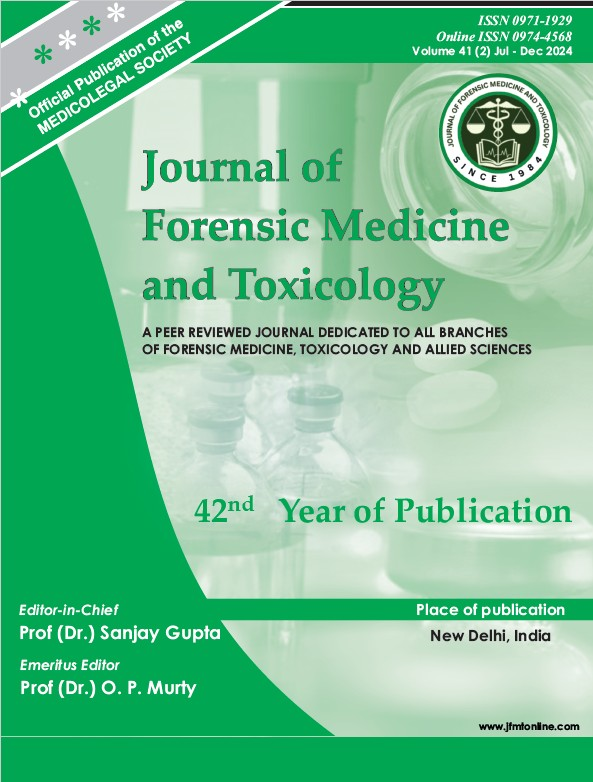A CROSS-SECTIONAL STUDY OF FATALITIES RESULTING FROM SNAKE BITES REPORTED TO SCB MEDICAL COLLEGE AND HOSPITAL, CUTTACK, ODISHA
DOI:
https://doi.org/10.48165/jfmt.2024.41.2.33Keywords:
Snakebite, Victims, treatmentAbstract
Introduction: Snakebite is a serious issue in India affecting rural dwellers. India has the unfortunate distinction of having the highest number of snakebite cases, leading to a staggering number of recorded fatalities worldwide. The species variation is highest in this region. Aims and Objective: The study aims to establish the prevalence of species involved in snakebite cases admitted to the hospital and to analyze the demographic profile of medico-legal autopsies conducted on snakebite victims at the mortuary of SCB Medical College, Cuttack, from September 2018 to August 2021. Methods: A self-designed questionnaire was prepared to obtain data on victims. Statistical analysis was performed using SPSS Statistical software. The sample consisted of 333 fatal cases received during the period. Results: Middle age group people (41–50 years) were most affected. Most of the victims were dependent women and children. Night time during sleep was the most suitable period for snakes to attack. Neurotoxic envenomation death was found to be more prevalent especially due to krait bite omited. Our study identified rural residency and indoor encounters with snake species as significant risk factors for snakebite. In most cases, there was a time gap of 1 to 6 hours between snake bites and admission in hospitals. However, in some instances, this gap extended even further, ranging from 12 to 24 hours. Discussion: The study concluded that the delay in treatment led to a high number of deaths. Therefore, early admission to the hospital and timely detection and treatment strategies could significantly reduce snakebite mortality.
Downloads
References
Sachan D. The snake in the room: Snakebite’s huge death toll demands a global response. BMJ 2018;361:k2449. Available from: https://doi.org/ 10.1136/bmj.k2449.
World Health Organization. Prevalence of snakebite envenoming. Available from www.who.int/snakebites/ epidemiology/en. Accessed on: 17 may 2021.
Mohapatra B, Warrell DA, Suraweera W, Bhatia P, Dhingra N, Jotkar RM, et al. Snakebite mortality in India: A nationally representative mortality survey. PLoS Negl Trop Dis 2011;5:e1018. Available from: https://doi.org/10.1371/journal.pntd.0001018.
Bawaskar HS. Snake bite poisoning: A neglected life threatening occupational hazard. Indian J Crit Care Med 2014;18:123–124. DOI: 10.4103/0972-5229.128698.
Simpson ID. A study of the current knowledge base in treating snake bite amongst doctors in the high risk countries of India and Pakistan: Does snake bite treatment training reflect local requirements? Trans R Soc Trop Med Hyg 2008;102:1108–1114. DOI: 10.1016/ j.trstmh.2008. 04.013.
Ahsan H, Rahman M, Amin R, Chowdhury E. Status of snake bite at a rural community of Bangladesh: A survey. J Curr Adv Med Res 2018;4:17–22.DOI: 10.3329/jcamr.v4i1.36170. Indian Journal of Critical Care Medicine, Volume 26 Issue 12 (December 2)
Subedi N, Paudel IS, Khadka A, Shrestha U, Mallik VB, Ankur KC. Knowledge of first aid methods and attitude about snake bite among medical students: a cross sectional observational study. J Occup Med Toxicol 2018;13: 26.
Bhaumik S. Snakebite: A forgotten problem. BMJ 2013;346:f628. DOI:10.1136/bmj.f628.
Venkatesan M, Dongre AR, Kalaisevan G. An epidemiological study of animal bites and envenomings in a rural district of Tamil Nadu, India. Online J. Helath Allied. Scs 2014; 13(4): 4.
Chugh et.al. Snake bite induced acute renal failure in India. Kidney International. Vol 35 (1989) pp 891-907.
Li W et.al. The risk factors of snake bite induced AKI. Med.Sci.Monit, 2016; 22: 2335-2339.
Whitehall J.S et.al. Snake bites in North and Sri Lanka. International Electronic Journal of Rural & Remote Health Research.
Bhalla .G, Mhaskar D, Agarwal A. A study of clinical profile of snake bite at tertiary centre. Toxicol Int 2014; 21: 203-8.
Alakesh Halder et, al. Study of Epidemiology, Morphological and Histopathological changes of stomach and kidneys in Poisonous Snake bite: JMSCR vol 5 Issue 2 Feb 2017(17898-17902).
Bhat RN. Viperine snake poisoning in Jammu. J. Indian Med Assoc. 1974; 63: 383-92.
Saini RK, Sharma S, Singhs, Pathania NS. Snake bite poisoning, A preliminary report. Assoc.Physicians India 1984; 32: 195-7.
Sarangi A, Jana I, Das JP. Clinical profile of snake bite poisoning. J. Assoc. Physicians India 1977; 25: 55-60.
Harshavardhan L, Lokesh AJ, Tejaswari HL et.al: A study of acute kidney injury in snake bite victims in a tertiary care centre. Journal of clinical and Diagnostic Research. 2013 May, Vol 7(5) 853-856.
Bawaskar HS, Bawaskar PH. Profile of snake envenoming in Western Maharashtra. India.Trans Roy Soc Trop Med. Hyg 2002; 96:74-84.
Monteiro NP, Kanchan T, Bhagavath P, Praddep kumar G. epidemiology of cobra bite in Manipal, Southern India. J. Indian Acad. Forensic Med. 2010; 32(3): 224-27.
Brunda G, Shashid R.B. Epidemiological profile of snake bite cases from Andhra Pradesh using Immunoanalytical approach. Indian J. Med 2007; 125:661-5.
Kularatne SAM. Edpidemiology and clinical picture of Russell’ s Viper bite in Anuradhapura, Srilanka. A prospective study of 336 patients. Southeast Asian J. Trop Med Public health 2003; 34:855-62.
Rupinder sharma, Varundeep Dogra, Gurudutt sharma, Vivek Chauhan. Mass awarness regarding snake bite induced early morning neuroparalysis can prevent many death in North India. Int.J. Crit.Illn Inj. Sci 2016 July - Sep 6(3) 115-118.
Yogesh C, Satish K.V. study of clinicopathological profile of renal changes in snake bite cases for a period of 18 months reported to Victoria Hopsital, Banglore. International Journal of Scientific and Research Publications 2004; 8(4) p-15.
Kulkarni ML, Anees S. Snake venom poisoning: experience with 633 cases. J of Indian Paediatrics; 1994 Oct: 31(10): 1239-43.
Suchitra N et.al. Snake bite envenoming in Kerala, South India clinical profile and factors involved in adverse outcomes. Emerg. Med. J 2008; 25: 200-204.
Chidanda PS. Rao, Prameshwar Shirappa et.al. Fatal snake bites - sociodemography, latency and pattern of injuries. J. Occup. Mod. Toxicol: 2013; 8-7.
Patel TB, Basnod YV. Snake bite induced acute renal failure: A study of clinical profile and predictors of poor outcome : Ann Trop. Med Pub Health. 2012; 5: 335-9.
Rubina Naqui. Snake bite induced acute kidney injury. J. Col. Physicians & Sur. Pakistan




